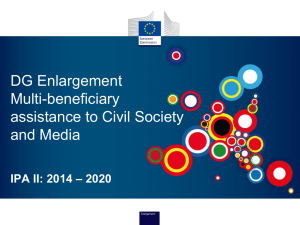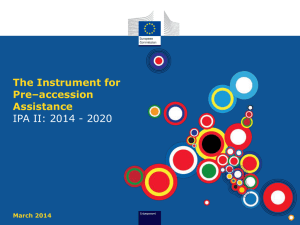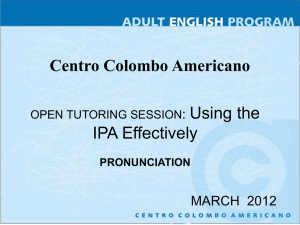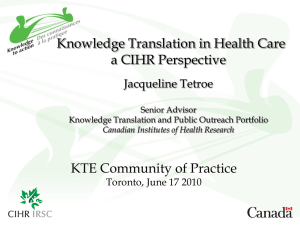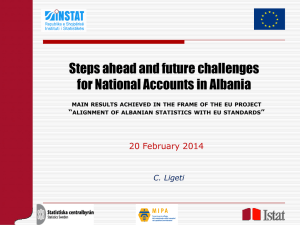IPA - Moodle - Tavistock and Portman
advertisement
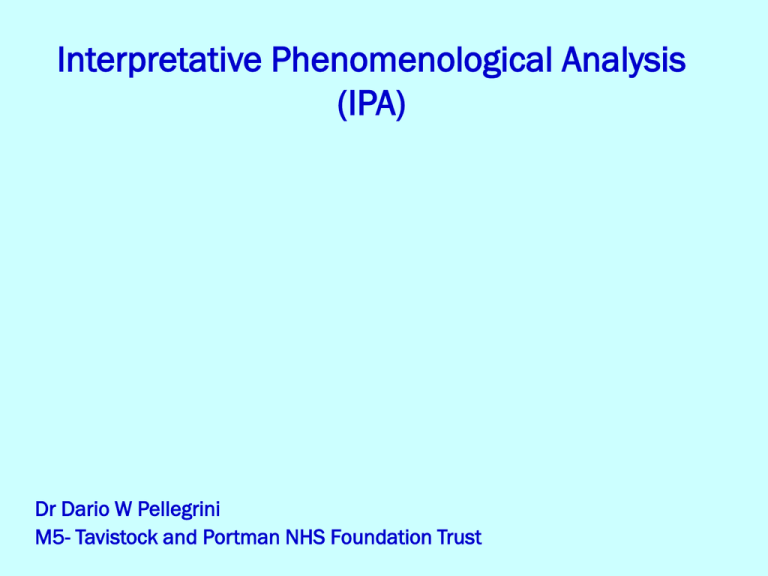
Interpretative Phenomenological Analysis (IPA) Dr Dario W Pellegrini M5- Tavistock and Portman NHS Foundation Trust Aims • To outline the theoretical bases of IPA • To describe the main differences between IPA and other qualitative methods of data analysis • To reflect on some of the critiques of IPA • To describe the steps in IPA data analysis • To watch a video clip describing IPA text analysis and discuss • To carry out a short IPA data analysis activity • To describe the expectations for an IPA study • To reflect on issues of trustworthiness and validity in IPA based research Theoretical bases of IPA • Phenomenology • Hermeneutics • Idiography Phenomenology Study of experience. Contributions to IPA are: • Reflection on experience/ bracketing: Husserl: • Dasein (there-being): Heidegger • Embodiment: Merleau-Ponty Hermeneutics Theory of interpretation of texts. Contributions to IPA are: •Fore-structures/ bracketing: Heidegger •Hermeneutics of empathy and hermeneutics of suspicion: Ricoeur •Larkin et al (2006); Smith (2004) and Smith et al (2009) : propose hermeneutics of meaning / recollection (descriptive and interpretative) Idiography • Concern with the specific, the detail and the understanding of individual experience • No claims about whole populations but focus on individual experience and proposes theoretical generalisation IPA and other qualitative methods of data analysis • IPA vs. Grounded Theory • IPA vs. Thematic Analysis • IPA vs. Discourse Analysis Critiquing IPA • IPA and language: language as a tool/ role of language in constructing experience • Role of context in IPA • Role of cognition in IPA Steps in IPA data analysis Transcript is read and re-read Initial notes are made in the transcript Emergent themes are created from initial notes Emergent themes are clustered into sub-ordinate themes The same process is repeated for all individual transcripts Sub-ordinate themes for all individual transcripts are clustered into super-ordinate themes Super-ordinate themes are clustered into overarching concepts for the sample IPA text analysis: Michael Larkin http://www.youtube.com/watch?v=IQPzRefe mw8 Activity • • • • • • Dewey One of six participants Middle aged Man EP for over 5 years FT for over 2 years OVERARCHING CONCEPTS THE SELF IN TIME SUPER ORDINATE THEMES SUBORDINATE THEMES REFLECTING ON THE SELF BEFORE FT TRAINING Wish for change Understanding of FT prior to training Inspirations and first encounters Process Context Techniques Reflecting on the self Professional labelling Enabling Potential for conflict Self reflections on difference Others’ reflections on difference REFLECTING ON THE SELF POST FT TRAINING A DIFFERENT SELF MULTI AGENCY THE SELF AND THE OTHER ENABLING HINDERING DIFFERENCES FROM OTHER NON FT TRAINED PROFESSIONALS PEOPLE IN / OUT SERVICE SYSTEMIC SUPERVISION PERSONAL BELIEF SYSTEMS TIME PERSONAL LACK OF SYSTEMIC SUPERVISION SERVICE Table 5: visual map of results Trustworthiness • QUAL-QUANT methodologies have different criteria to establish trustworthiness of research • Trustworthiness needs to come from ‘within’ rather than ‘without’ factors (Morse, Barrett, Mayan, Olson & Spiers, 2002) • Elliott, Fisher, Rennie (1999); Robson (2002; 2009); Yardley (2000; 2008) some strategies to ensure trustworthiness of Qualitative Research. • Yardley (2008) has developed a set of four criteria, relevant to Qualitative Research. Yardley (2008) • Sensitivity to context • Commitment and rigour • Coherence and transparency • Impact and importance Trustworthiness of IPA research What makes a good IPA study? (Smith, 2011) • Clear focus rather than broad reconnaissance • Strong data obtained by a purposive sample typically small. • Gives measure of prevalence for a theme: evidence base should be drawn from a large proportion of participants, but beware ‘THEMOLATRY’ (Dario’s neologism: Theme – idolatry) (Chamberlain, 2011; Smith, 2011) • Sufficient elaboration of a theme • Interpretative commentary, not just descriptions (difference between papers and theses) • Show convergence and divergence between different participants, without losing the uniqueness of individual experience • Well written Aims • To outline the theoretical bases of IPA • To describe the main differences between IPA and other qualitative methods of data analysis • To reflect on some of the critiques of IPA • To describe the steps in IPA data analysis • To watch a video clip describing IPA text analysis and discuss • To carry out a short IPA data analysis activity • To describe the expectations for an IPA study • To reflect on issues of trustworthiness and validity in IPA based research References • • • • • • • • • • Burr, V. (2002). The person in social psychology. Hove: Psychology Press Chamberlain, K. (2011). Troubling methodology. Health Psychology Review, 5 (1) 4854. Elliott, R., Fischer, C.T. and Rennie, D.L. (1999) ‘Evolving guidelines for publication of qualitative research studies in psychology and related fields’, British Journal of Clinical Psychology 38: 215-29. Morse, J.M., Barrett, M., Mayan, M., Olson, K., & Spiers, J. (2002). Verification strategies for establishing reliability and validity in qualitative research. International Journal of Qualitative Methods, 1 (2), 13-22 Nightingale, D.J., and Cromby, J. (1999) (Eds.). Social constructionist psychology: A critical analysis of theory and practice. Buckingham: Open University Press Robson, C. (2002). Real World Research (2nd Ed.). Oxford, UK: Blackwell. Smith, J.A. (2004). Reflecting on the development of interpretative phenomenological analysis and its contribution to qualitative research in psychology. Qualitative Research in Psychology, 1, 39-54. Willig, C. (2008). Introducing qualitative research in psychology (2nd Ed.). Maidenhead, UK: Open University Press Yardley, L. (2000) ‘Dilemmas in qualitative health research’, Psychology and Health 15: 215-28. Yardley, L. (2008). Demonstrating validity in qualitative psychology. In. J.A.Smith (ed.). Qualitative psychology. A practical guide to research methods. (2nd ed.). London: SAGE, 235-251.


